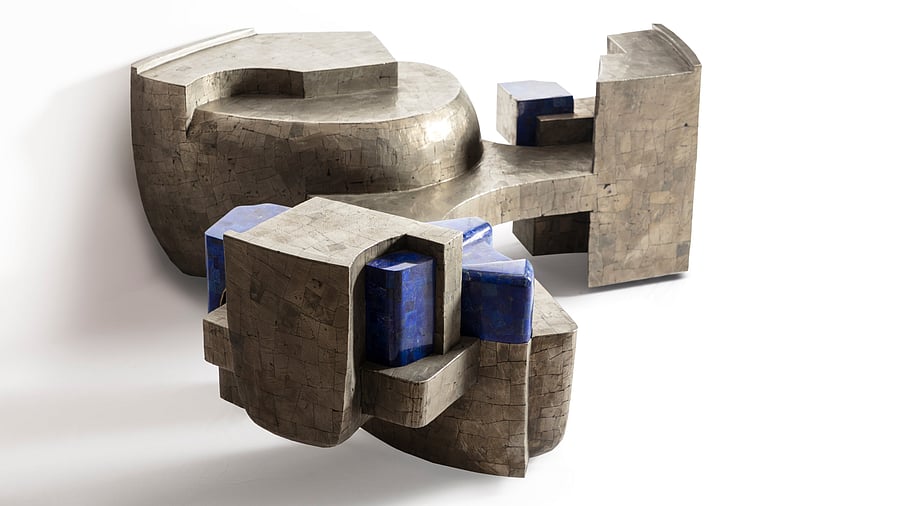
From installations that reflect the land to furniture that carries its essence, these pieces transform the spirit of places into something you can feel and experience, sparking a conversation between us and the environment through art.
Urban textures
Artist M Pravat, upon moving to Delhi, found inspiration in the city’s rapid expansion and dynamic landscape. In one of his notable works, he transforms a pillar into a canvas, turning a structural necessity into a thoughtful reflection of Delhi’s urban landscape. The brick and stone work resembles a map, with three-dimensional clusters symbolising the density of urban settlements. The artwork captures Delhi’s fragmented yet interconnected spirit. “The city seems broken from an aerial view, but there’s a quiet harmony in its form,” Pravat muses.
The sharp lines and raw textures embody the constant push and pull between chaos and calm — an ode to the city’s dual nature. His art explores the emotional contrasts that pulse through urban life — light and shadow, movement and stillness. For him, art is a medium where these contrasts can coexist, much like the city itself. The materials he chooses — recycled bricks, stone, slate, and marble dust from construction sites —add depth to the story. “These materials are symbols of Delhi’s constant cycle of destruction and renewal,” he notes. Each texture, each hue, carries the city’s essence, grounding his art in the ever-evolving narrative of Delhi.
Hampi into a table
Joya Nandurdikar, co-founder of a venture that collaborates with local artisans to create handmade furniture, designed a sculptural coffee table inspired by her visit to Hampi. The piece, crafted from natural stone, draws from the boulder-strewn terrain and ancient temples of the region. The natural stone used in the table adds a sense of permanence, grounding the piece in the timelessness of Hampi’s beauty. Its undulating edges and textured surfaces mirror the rugged landscape, while the geometric symmetry and interlocking shapes subtly echo the architectural rhythms of the temples, symbolising the harmony between natural landscapes and the built environment at Hampi. The table shows Joya’s connection to the land, sparking chats about the area’s rich history and stories.
Nature sculpted
Harjot Singh, principal designer and art director at a firm focused on material innovation and artistry, reimagines furniture as sculptural art that seems to belong to the landscape itself. His creations — a side table, console, and shelving unit — are inspired by the organic flow of cave rock formations and the whimsical, fluid shapes of Antoni Gaudí’s work. Harjot’s designs appear as if they have risen from the earth, drawing us into a deep connection with nature. The core material in his work, Pesta Mozecco, is a finish made from upcycled paper, wood waste, and metal scraps. This eco-conscious approach gives each piece a textured, stone-like surface that evokes the rugged beauty of nature. The designs reflect the slow, powerful processes of nature itself, much like rivers sculpting stone over time, creating pieces that feel like they’ve always been there. Rounded edges, echoing nature’s flowing forms, ensure each piece is not only visually captivating but also practical and safe for everyday use.
Wilderness collage
Vikrant Sharma, co-founder of a design firm, transforms wildlife photography into collage wall art, creating a powerful, personal connection between the viewer and nature. The work combines photographs from national parks in India and Africa, capturing moments of wildlife. Rather than simply printing and framing the photos, Vikrant alters them. Using coffee staining, he gives each image an aged, vintage feel, as if they’ve been preserved through time. The idea is to bypass the usual freshness of modern prints and create something more enduring, in line with the ancient, timeless beauty of nature itself.
The stains, carefully applied, lend the images a textured, earthy quality, pulling one closer to the wilderness they represent. The frames play a crucial role in the artwork, not just as borders but as extensions of the images themselves. Each frame is hand-painted to reflect the elements within the photographs, creating a seamless flow from one scene to the next. For instance, a giraffe’s neck morphs into a tree branch, from which a bird takes flight — details that feel as though they’re spilling out of the frame, inviting the viewer to enter the scene. “It’s about making the viewer feel like the art is reaching out, pulling them into the story,” Vikrant explains.
These artworks go beyond the visual — they immerse you in the essence of the places they draw from, evoking a lasting connection. Whether it’s the textured chaos of Delhi, the ancient stones of Hampi, the organic flow of nature in sculptural furniture, or the wilderness collage, these pieces quietly connect us to the land. They make us pause, observe, and shift our perspective.